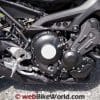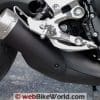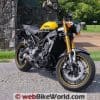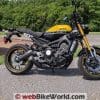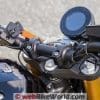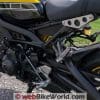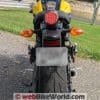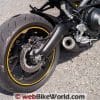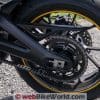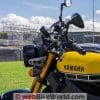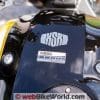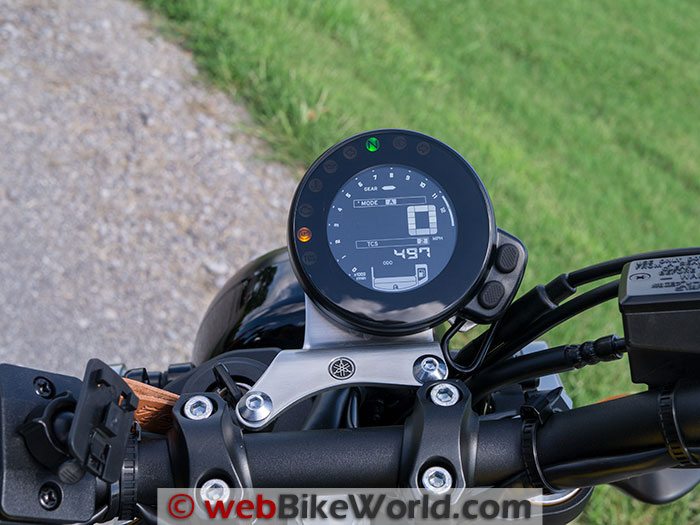Sport, Retro and Heritage
If you’ve been following Yamaha’s string of new motorcycle model announcements over the past few years you know they’ve been busy.
One of the jewels in the newly minted lineup is the triple cylinder FZ-09 (MT-09 outside the US market), released in 2013.
The new 847 cc three-cylinder engine received a lot of praise from the press and FZ-09 owners, despite some “abrupt” fuel issues transitioning from a fully closed throttle.
Beyond these teething problems with fuel mapping, the FZ turned out to be a blast to ride and this helped it overcome the early production issues.
The FZ was followed up by the FJ-09 (Tracer 900 overseas), a sport-touring version based on the same engine in 2015.
By the release of the FJ-09, the fueling issues had been addressed and for 2016 a third model based on the triple engine was released.
The new 2016 bike would be closer in spec to the FZ-09 and on paper it is very difficult to tell one from the other because fuel capacity, wheelbase, rake and trail, etc. are all similar.
But cosmetically, the bikes appear distinctly different. So let’s take a quick look at the Yamaha XSR900, a melding of sport, retro and Yamaha history from their new “Sport Heritage” collection.
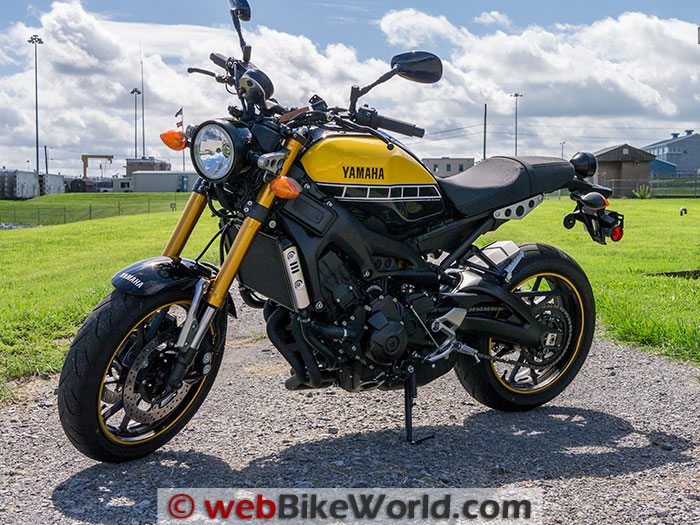
The XSR900
The XSR-900, shown here in the 60th Anniversary livery, is a member of what Yamaha is referring to as their “Sport Heritage” line of bikes.
This group includes the XSR900, the SR400 ingle cylinder, the Bolt C-Spec, the new SCR950 “Scrambler” and the venerable V-Max.
It doesn’t take long after viewing the XSR900 and the FZ-09 side-by-side to tell that the two bikes share quite a bit of their substance; the engine, frame and swingarm all appear to come from the same parts bin.
This is not a bad thing.
While the FZ-09 has been lauded as a fun bike to ride, the “looks” have definitely been more divisive among reviewers.
Personally, I’m not thrilled with the looks of the FZ-09, but then again I’m not turned off by it either. It simply is.
What the Yamaha has done with the XSR900 is taken a good base and put it in a new wrapper and the result is more than just the sum of its bolt on parts.
To me, the cosmetic changes have transformed the bike with a perfect blend of old and new.
The XSR900’s looks definitely recall the appearance of a few Japanese motorcycles from the 1970’s, yet it looks fresh and hits the buttons for the current retro trend.
Yamaha dipped into their past with the XSR900, especially with the 60th Anniversary edition yellow Yamaha paint scheme (a $500.00 option).
The bikes that come to mind are the inline triples of that era; in fact, both Yamaha and Kawasaki released motorcycles in the 1970’s with three cylinder engines, including the Yamaha XS750 (and later the XS850).
They weren’t huge sellers, but the bikes had a reputation for being smooth and reliable.
Fast-forward to present day and you can see how the new meets the old with the XSR900. Built on the FZ-09 base, the XSR presents some very interesting and functional design touches.
The Loaner XSR900
The XSR900 shown here is part of what might be called an “extended” stable of bikes we have access to at webBikeWorld.
In fact, this one now belongs to my (Brandon Jackson) good friend Johnny Jarvis, who will be adding some farkles and will report back to webBikeWorld readers.
Johnny has actually helped with previous webBikeWorld reviews; in fact, he can be seen in the video included in the JIS screwdrivers review.
He has been riding motorcycles since his early teens and he’s owned just about every style of motorcycle there is, including sportbikes, cruisers, muscle bikes, dirt bikes (2 and 4 strokes) and standards.
Since he has had such a diverse range of bikes in his past, I asked what formed his decision to choose the XSR900.
He told me he really enjoys the power and handling of a sportbike, but like many of us approaching (or in) middle age, the ergonomics of many modern sportbikes don’t quite suit him.
He’s seen many of the current generation of “naked” or standard bikes, many of which are based on full on sportbikes, but none really spoke to him.
It’s not just in the appearance but Johnny is 6’2″ tall (188 cm) and many bikes feel too small for him.
But when he saw the XSR900 photos before it was released, he was instantly smitten with the looks. Having owned a yellow Yamaha RD350 in the past, this modern machine pushed the nostalgia buttons.
On paper, the bike seemed like it would check all the right boxes for performance, so despite having not seen one in person, he put down a deposit down and began the wait for a 60th Anniversary Edition to arrive.
First Impressions
The first thing I noticed when seeing the XSR900 60th Anniversary Edition in person was the fuel tank.
It took a moment for me to figure out that the bright yellow paint (complete with speedblocks!) was not actually on the tank itself but instead on panels that flank the center of the tank.
Those panels are not plastic but aluminum. This makes sense only after viewing a non-60th anniversary model with the brushed aluminum look on those same covers.
The shape of the tank and covers give it a vintage look, while being thoroughly modern in the quality of the paint and materials.
The single round headlight is another example of this philosophy.
At first glance it looks like the average sealed beam and bucket headlight of the past but the reflector design and bulb are modern and more effective that one might expect.
Also, the thick headlight brackets look like billet (they’re not) and they also look like something that would be at home on a “Hot-Rod” or custom bike.
This is also true of the front fender brackets, which are supporting a glossy black painted plastic fender (the rear fender is metal).
Similarly, styled brackets are present on the sub-frame under the seat as well as aluminum side covers on the radiator and the bracket holding the instrument cluster.
There are several other subtle styling touches, such as the round vintage-look taillight that houses LEDs; the round instrument cluster and the one-piece seat.
All of these add up to a blend of modern and retro.
By the way, a couple of things to note: the yellow wheel stripes were installed by the owner of the bike and sharp-eyed viewers may also spot the aftermarket grips on the handlebars. These are the Koso “Apollo” heated grips and we have a review coming soon.
Yamaha chose to make these aesthetic “winks” at the past but didn’t go to any lengths to try and fool an onlooker into believing this is a vintage machine.
That’s pretty much the opposite of some other “retro” bikes; for example, the Triumph Bonneville, with its “carb looking” fuel injection throttle body covers.
The result on the XSR900 is a modern standard motorcycle that just looks great, but the greatness doesn’t stop with the looks.
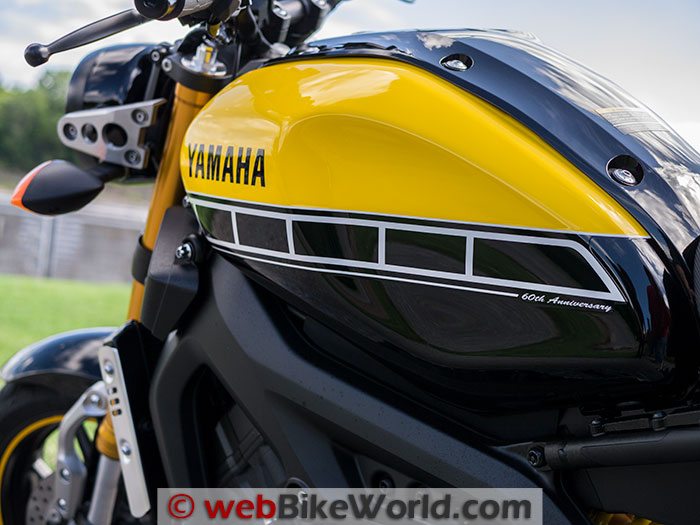
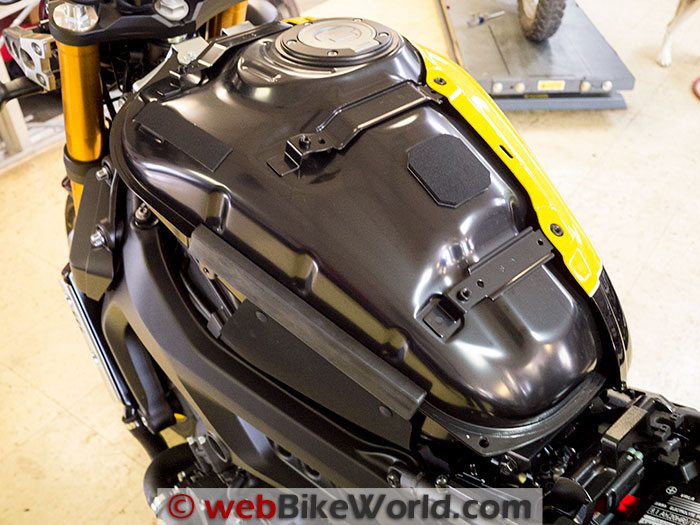
On the Street
After a few minutes of looking over the machine, Johnny asked me if I wanted to take it for a ride. This is the sign of true friendship and trust!
At that time, his new ride had less than 100 miles on the odometer and yet he gladly handed over the keys for me to have a go with it.
Since it hadn’t reached the end of the break-in period yet, taking it easy would be the order of the day but that was OK and I found out what I needed to know.
Throwing a leg over the XSR, I was greeted with a comfortable and well-padded seat. Reaching for the controls didn’t take much forward lean and I instantly felt at home.
Thumbing the starter woke the XSR up easily and I dropped the transmission into 1st.
Taking off from a stop took a little more twisting of the throttle than I expected, however; the bike was in the “standard” engine mode, which splits the difference between the less responsive “B” mode and the fully awake “A” mode.
Johnny mentioned that I should try out “A” mode before I left and after only two intersection stops, I switched it over. This brings the 847cc triple to life.
The engine was now responding like I would expect an engine of this size and configuration to behave.
I’ve seen a few video reviews of the XSR900 leading up to my own experience and I can see how it has been so easy for other riders to loft the front wheel on this bike.
Of course, I made a point to leave this one resting on two wheels during my test ride, however.
It should be noted that the engine mode settings are saved in memory after the bike is shut down. This is a nice feature, as you don’t have to reset the fueling mode every time you take the bike out.
Unfortunately, the same isn’t true of the traction control system, which returns to the default setting after every shut-down.
I also did not investigate the traction control settings, because taking an easy spin on a brand-new motorcycle I don’t own probably isn’t a good idea.
Even while keeping the revs low-ish to respect the break-in recommendation, the grunt available in the low rev range was excellent.
The transmission felt a bit notchy but after a few minutes of warm-up, the gears started meshing in a more friendly fashion.
This is something that Johnny tells me has improved greatly as the miles have been piling on.
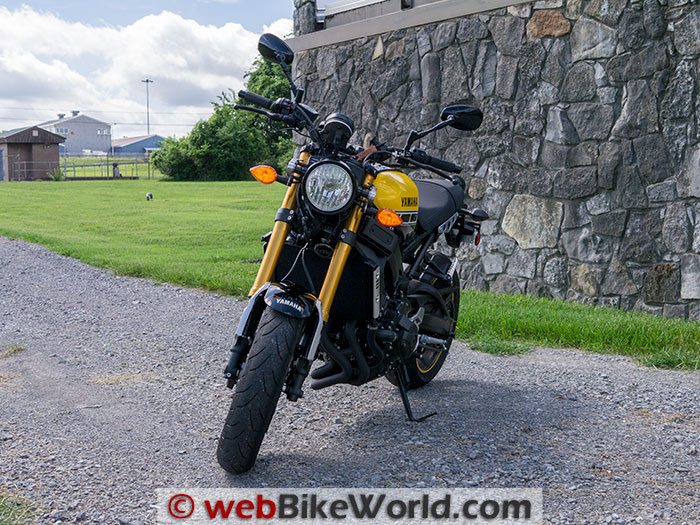
Handling
Response to input from the tapered dirt bike style handlebars was quick and clean. The XSR feels very nimble and the linear power from the engine, a trait of most triples, is simply grin-inducing.
And stopping is nearly as fun as going; the 4-pot calipers up front (with ABS) provide sportbike levels of inertia reduction.
The XSR900 is fitted with a slipper clutch that reduces back-torque and makes accidental chops of the throttle a non-dramatic event.
It took me a few minutes to get used the reduced engine braking but one soon forgets about it.
The suspension setup on the XSR900 is what I would call mid-range. The forks are of the upside-down variety and offer preload and rebound damping controls, while the rear shock is adjustable in the same ways.
I understand that even though the rake, trail, and suspension travel numbers between the XSR and the FZ-09 are the same, the spring rates are different between these two bikes.
I don’t have access to an FZ-09 at the moment but the factory settings seemed well sorted during my initial ride on this XSR900. I rode on secondary roads with a variety of surfaces and the suspension felt firm but not harsh.
Even railroad crossings didn’t do much to upset the poise of the bike and all the while, I could hear the engine running beneath me. There’s a lot of mechanical noise going on and it is good.
My Triumph triple had a similar din when it was spinning and while the XSR has a different tone, it still makes me think “triple”.
One noise that is very subdued, however, is the exhaust. Johnny told me during my walk-around in the driveway that he intended to replace the exhaust with a new slip-on or possibly a full exhaust system very soon.
I thought the stock can actually looked very smart and relatively small for a stock exhaust, but after riding the bike, I was surprised at how quiet the engine note is.
Looking at the XSR900 from a lower angle, you can see the large collector underneath the engine, which is no doubt putting a hush on the noise.
While I’m not one for having loud uncorked pipes on a street bike, it does seem like the XSR deserves a bit more growl.
I’ll be interested to hear the triple breathe through a less restrictive pipe if and when the change is made.
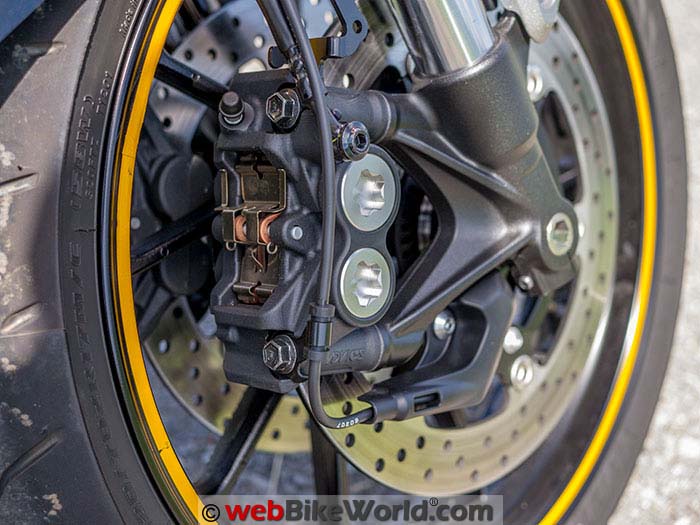
Ergonomics
The XSR900 isn’t a large bike…but it isn’t tiny either.
It feels light on its feet and looking at the placement of the engine and the under-slung exhaust, it all makes sense.
The handlebar-to-seat-to-foot peg setup covers a good range of rider sizes. For example, I’m 5’10” (178 cm) and Johnny is 6’2” (188 cm) and both of us think the seating position is perfect for a standard bike.
Because the XSR900 has a handlebar and not clip-ons, the bar height, width and pull-back are relatively easy to modify.
Of course, beyond a certain amount of change the brake lines and wiring might need to be re-routed or replaced.
I mentioned early on in this review the round instrument cluster and it is one of my favorite dichotomies found on the XSR.
The small and round housing suggest a simple analog speedometer but instead, it is a fully modern white-on-black (gray?) LCD display, encircled with a series of indicator lights from the eight o’clock to the one o’clock positions.
For such a small display, a lot of information is being shown.
There is a numerical speedometer in the center of the display, while a circular tach gauge runs around the outer edge.
In addition, there is a four-step fuel gauge at the bottom, while a gear indicator rests at the top.
Information about the engine and traction control modes are also visible along with the odometer.
The odometer can be also change to two separate trip meters using the buttons at the four o’clock position on the outside of the display.
Even more information is available using the buttons to cycle through displays of ambient temperature, coolant temperature, a clock and trip computer information like average fuel consumption and fuel reserve trip meters.
The warning lights include the usual suspects of oil pressure, check engine, high temp warning, neutral and turn indicators.
Lights for ABS and TCS “off” are also included.
The position of the display is good and easily visible without much head tilt, at least in my case, but different helmets and rider height will of course vary the opinions.
The display itself is a bit on the small side though, so while speed is pretty easy to see at a glance, the other data might take a moment to discern, depending on the rider’s vision.
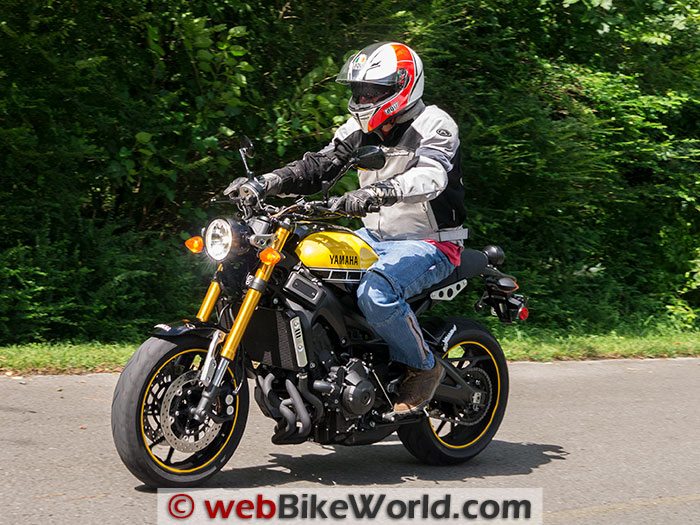
Conclusion
The Yamaha XSR900 is sort of a 2016 version of a Japanese “standard” bike, but in the retro idiom.
The blend of riding position along with the “winks and nods” to classic bike designs from decades past make for a 2016 version of the 1970’s Japanese motorcycle experience.
And while the XSR900 also has the performance to back up its sporty looks, the modern electronics like ABS, engine modes, and traction control are there to rein in your hooligan tendencies if needed.
It’s easy to look at the XSR900 specs and assume this is just another “parts-bin” bike and I suppose that at a basic level, it’s what it is.
But even though it shares so much of its underpinning with the FZ-09, the XSR900 still stands out very well against its sibling.
The one takeaway that sticks with me after riding the XSR is that it is fun and the fun factor for a motorcycle should be at the top of the list for any rider, otherwise what’s the point, right?
A versatile, reliable, and fun motorcycle. Sounds like the 1970’s all over again!
Publication Date: September 2016
Master Listing of All wBW Motorcycle Product Reviews
Owner Comments and Feedback
See details on submitting comments.


